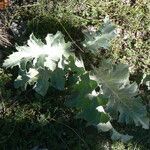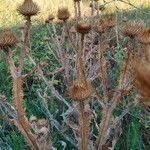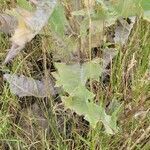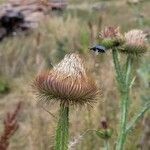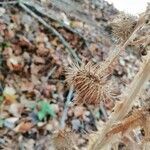Taprooted biennial. Stems branched above, covered with dense, white felted tomentum, 1-3 m tall, with broad dentate spiny wings 5-18 mm wide. Lvs deltoid to ovate to lanceolate, shallowly pinnatifid, coarsely dentate, grey-green, 20-30 × 15-20 cm, with dense fine felted tomentum above and beneath; prickles marginal, yellowish, spreading, 5-10 mm long. Capitula broadly ovoid, waisted at flowering, erect, 2-4-(5) × 2-4-(5) cm, solitary; peduncles elongating just before anthesis, 5-15-(25) cm long. Involucral bracts linear-subulate, 2-3 mm wide at base, the outer and middle with dense cobwebby tomentum; apex spinous, spreading to suberect. Corolla purple or white, 20-24 mm long; lobes unequal, 5-7 mm long. Style exserted 3-4 mm beyond corolla lobes. Achenes dark, narrowly obovoid to clavate, weakly transversely flattened and 4-angled, rugose, 5-6 × 2-2.5 mm; ribs 4, pale; pappus bristles scabrid, 5-10 mm long.
Herb to 1.8 (–2) m high. Stems densely arachnoid-tomentose; wings 5–20 mm wide. Leaves grey, with moderate to dense arachnoid tomentum on both surfaces; sessile glands absent; marginal spines 4–7 mm long, creamy to yellowish. Capitula solitary on 15–30 cm long peduncles; involucre oblate to globose, 25–45 mm diam. excluding patent bracts; median involucral bracts erect, linear, 14–21 mm long, 1.5–2.3 mm wide, entire or serrulate, arachnoid-tomentose. Corolla purple; tube 14–18 mm long; lobes 5–7 mm long, glabrous. Anthers 6.5–8 mm long. Achenes cuneiform, obscurely 4-angled, 4.1–5 mm long, with numerous prominent transverse wrinkles, brown or brown with black dapples. Pappus bristles barbellate, 73–119, 9–11 mm long.
A herb. The young plant is a ring of leaves near the ground. A mature plant is 1.5 m high. The stem is round in cross section. It is hollow and has a mass of fine white hairs. The plant is woolly white in appearance. The leaves have lobes and also have strong spines. The flowering stems are leafy. The leaf blades continue down the stem. The flowers are reddish to purple. They are surrounded by many spiny bracts. These end in long orange spines.
